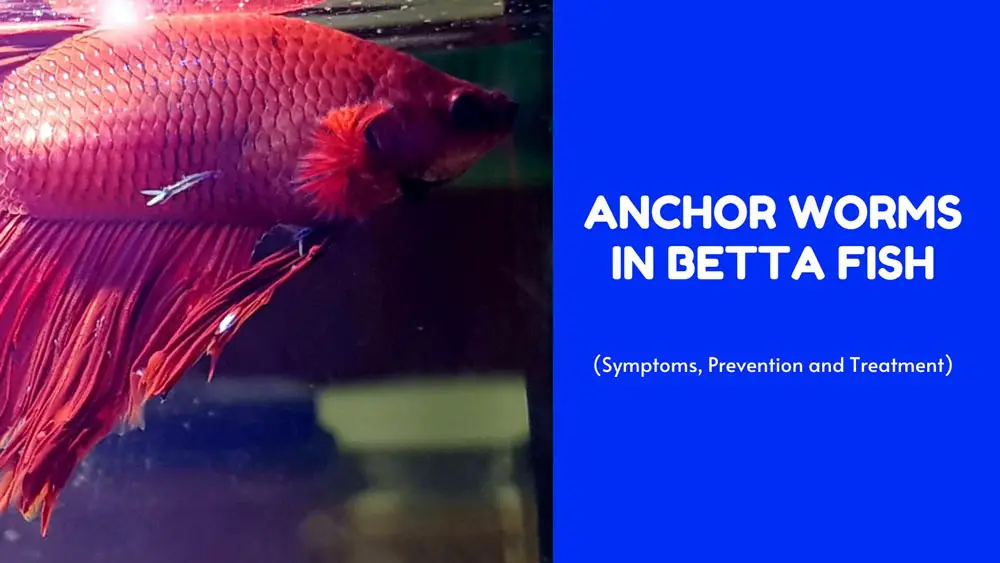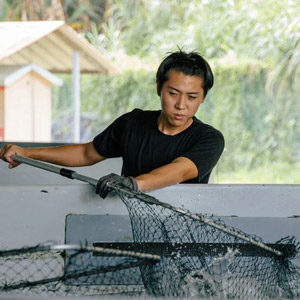Anchor worms in betta fish are less common than other parasites like Ich (aka white spot disease) and Velvet. They primarily affect goldfish and koi but can infect any freshwater fish or amphibians, like pet frogs and turtles, that don’t have proper quarantine protocols.
If you spot these macroscopic parasites on your betta fish, action must be taken immediately. The more time that passes without treatment, the harder it will be to remove them.
Keep reading as we talk about what is anchor worm and a few methods of removing them without harming your delicate finned friend.
What is Anchor Worm in Betta Fish?

Anchor worms, scientifically known as Lernaea spp., are not actually worms but a group of parasitic copepod crustaceans that primarily infect a wide range of freshwater fish (100+ species), especially wild-caught and pond fish.
Because of its wide global distribution [1], more than a hundred Lernaea and Lernaea-like species have been identified. One of the most recognized Lernaea species, both in the aquarium hobby and in aquaculture, is L. cyprinacea, which is considered as a serious pest around the world.
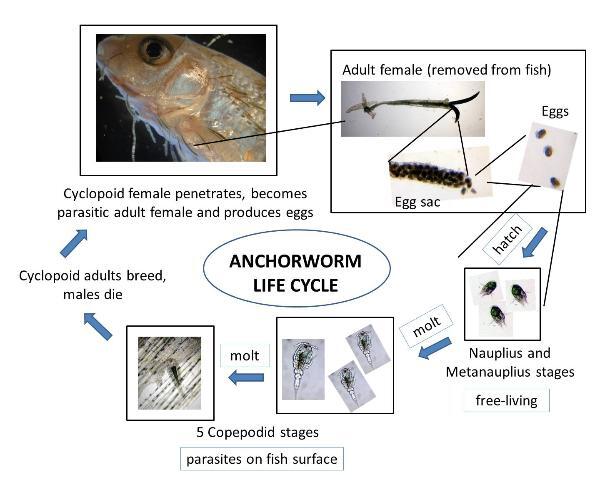
Credit: UF/IFAS Tropical Aquaculture Laboratory
As its relatives of crustaceans, such as crabs, lobsters, crayfish, krill, and shrimp, Lernaea species have a complex and multi-stage life cycle that can take up to 28 days to complete in tropical water. In code water, it could take up to a year. They don’t need an intermediary host, meaning they are able to swim from one fish to another.
Adult L. cyprinacea mate during the free-swimming stage (around 0.35″ in length [2]). After mating, the male dies, and the fertilized female burrows into the fish’s tissue through the scales, eventually using hook-like appendages to embed itself into the skin and muscle of the fish.
The long and slender “worm-like” growth that extends from the fish’s skin is actually the female’s egg sacs, hence its name.
Can Anchor Worms Kill my Betta Fish?
Anchor worms usually live on the skin, fins, gills, and oral cavity of the betta fish. They will enter the internal tissues after eating away fins and scales.
Although a small number of Lernaea isn’t deadly to betta fish, they might cause irritation to the betta fish, leading to inflammation and hemorrhage, ulceration, damaged fins, and severe secondary bacterial and fungal infections. These secondary infections can increase mortality rates in fish.
When larger numbers of Lernaea are present on the gill, they can interfere with the fish’s breathing, further increasing its mortality.
Symptoms of Anchor Worms in Betta Fish
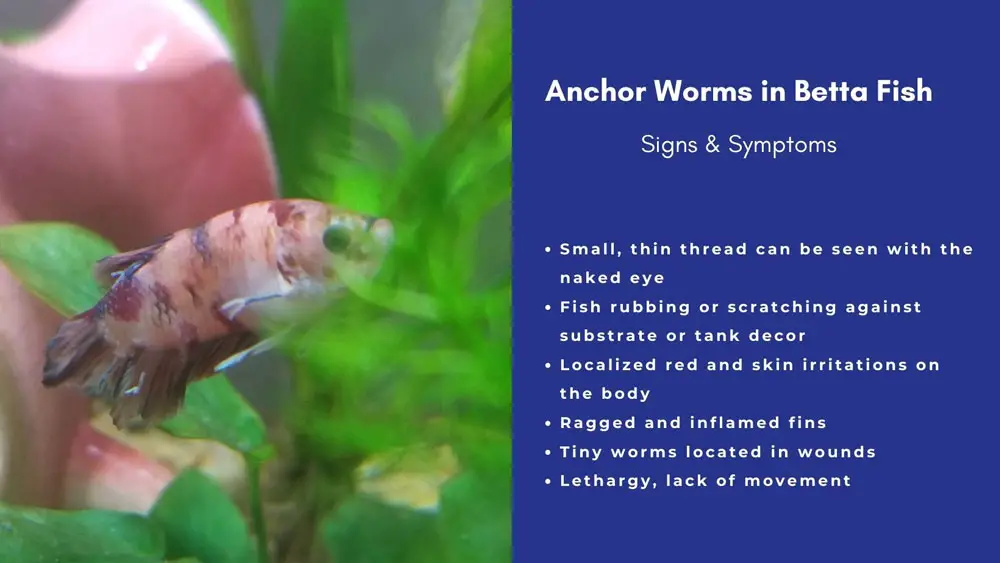
In the copepodid stages of Lernaea, they are visible to the naked eye appearing as whitish-green, small, thin threads. The following symptoms and signs are typically seen:
- Small, thin thread can be seen with the naked eye
- Fish rubbing or scratching against substrate or tank decor
- Localized red and skin irritations on the body
- Ragged and inflamed fins
- Tiny worms located in wounds
- Lethargy, lack of movement
Causes of Anchor Worms in Betta Fish
The most common reason for anchor worms is not quarantining new fish before adding them to the aquarium.
The female is quite prolific, producing 250 juveniles (nauplii) every two weeks for up to 16 weeks [3] in warm water above 77° F (25°C).
When you add a new betta fish carrying one or more juveniles or even eggs to an aquarium, they will hatch and spread rapidly. All new additions to your aquarium, including fish, shrimps, snails, and plants, should be quarantined for four to six weeks to ensure they are parasite-free.
We should also mention that anchor worms can also be transferred from fish to fish with netting, filter media, etc., so it’s important to sterilize nets and other equipment after use on infected fish.
Diagnosing Anchor Worms in Betta Fish
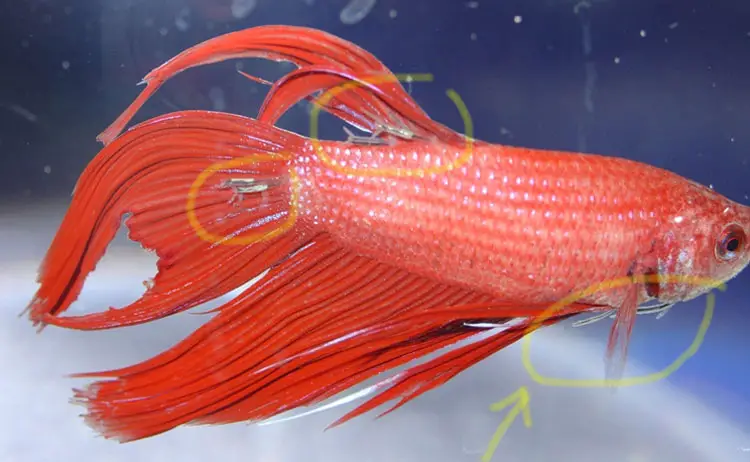
You will generally be able to diagnose this condition visually because these external parasites will be attached themselves to your betta fish.
If you are uncertain, take some clear pictures of the affected area and show them to your local aquatic veterinarian for a more accurate diagnosis under a microscope.
As mentioned, a betta fish with anchor worms will have one or more whitish-green threads measuring 0.4″-0.8″ and hanging from various parts of its body. These can be confused with algae, given their similar appearance. To diagnose this issue correctly, use a magnifying glass and shine a flashlight on the affected area.
Treatment
Since it can be relatively easy to identify this ailment yourself, the chances of recovery are high. However, varying suggestions are available on how to treat a betta fish that has been infested with anchor worms.
Regardless of which following method you choose; the best practice is to set up a hospital aquarium where you can treat them with chemical medications. More importantly, quarantining fish for more than seven days will break the life cycle of the anchor worm in the tank because larval stages cannot survive without a host for that amount of time.
Using Tweezers
Individual anchor worms can be removed by pulling them out from the fish using a clean pair of tweezers. However, you must carefully pull the entire parasite out, as they sometimes break off and leave the embedded head behind.
Once the anchor worm is out, antibiotics must be used on the infected area to prevent secondary bacterial infections.
Manual removal is impractical on some sensitive areas such as gills and mouth. In addition, if the parasite has burrowed deeply into tissue, attempting to remove it may cause more trauma than leaving it in. In these cases, other treatments should be sought.
Salt Dip
Aquarium salt (NaCl) – definitely not table salt or Epsom salt, is a cheap, effective, and widely available treatment known to work well against bacteria, fungus, and external parasites. Please keep in mind that MUCH more salt is not safe for plants, snails, and catfish – another reason you should treat anchor worms in a hospital tank.
Also, salt is NOT meant to be a long-term treatment option, but rather it should only be used for the duration of time it takes to cure the infection.
It’s most commonly used in a 30-minute bath, starting with the lowest level (1 tsp per 5 gals) and gradually increasing the concentration if the anchor worms persist.
- Contains one (1) API AQUARIUM SALT Freshwater Aquarium Salt 67-Ounce Box
- Promotes fish health and disease recovery with increased electrolytes
- Improves respiration for fish in freshwater aquariums
- Made from evaporated sea water for all-natural results
- Use when changing water, when setting up a new freshwater aquarium and when treating fish disease
Chemical Treatments
Because the females are more tolerant of salt, chemical treatments are more effective in breaking the life cycle in some cases. Popular options include:
Potassium permanganate
Potassium permanganate (PP) is a strong oxidizing agent with some anti-parasitic properties. A 30-minute dip in potassium permanganate at a concentration of 2 mg/L will kill larvae or eggs, but adults may survive.
Diflubenzuron or Dimilin
Diflubenzuron, also known as dimilin, is a chiton inhibitor that can kill larvae and molting adults. Usually available in liquid form, Diflubenzuron should be administered at a concentration of 0.066 mg/L.
- Dimilin -X Koi & Goldfish Treatment 1/2 gallon Anchor Worm Fish Lice Flukes diflubenzuron
Author notes: Do NOT use household insecticides as they have a special chemical class of active ingredients, pyrethroids, which are toxic to fish.
Copper
If you have treated Velvet or ich before, you may have copper medication lying around. Copper sulfate is an alternative anchor worm treatment, but it’s unsafe when your GH is lower than 6, as with many betta tanks.
It’s best to raise the GH to 6 or above by adding Tums tablets and then target anchor worms with the copper sulfate.
When treating anchor worms with a salt or chemical dip, observe the betta fish closely; if there are any signs of distress, immediately remove it from the dip. An air stone should be used to increase the oxygen levels during the dip.
Always put these chemicals away from your pets (and kids!), and wear gloves when handling them.
Afterward, the main aquarium should be sanitized, and all decorations should be disinfected in an effort to remove any remaining eggs or larvae before returning the betta fish back.
How to Prevent Ich Anchor Worms in Betta Fish
Anchor worm is an opportunistic parasite that can make its way into the betta fish tank through water changes, plants, or décor. If you detect the parasite early, you’re more likely to experience a successful outcome.
The best way to prevent anchor worms is to quarantine any new additions to your aquarium for 30 to 60 days [x].
Closing Thoughts
Fortunately, anchor worm infection is one of the relatively easy betta fish diseases to treat. Although anchor worms are often quite visible, it’s best to get a proper diagnosis before treating the condition using any of the above methods.
Be passionate about quarantining new arrivals, no matter where you get them from.
Good luck, and stay vigilant for anchor worms! A clean tank is a happy tank. 🙂
Article Sources:
- Lernaea cyprinacea, Anchor-worm copepod parasite [Marine Invasions Research]
- Lernaea cyprinacea [University of Michigan]
- Lernaea (Anchorworm) Infestations in Fish [University of Florida]
- Anchor Worms [Aquarium Science]
- Fish Baths, Dips, Swabs; Including Coral; For Disease, Ammonia, Treatment [Aquarium Answers, Pond]
